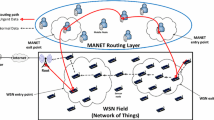Abstract
ZigBee networks utilize a mixed routing method combining hierarchical/tree routing and Ad hoc On-demand Distance Vector (AODV) routing. Tree routing is a proactive routing scheme that routes packets from sensors to sink based on the parent-child relationships formed during network setup, while AODV is a pure on-demand route acquisition algorithm that broadcasts discovery packets when a route needs to be established. Studies in the open literature have shown that tree routing has many advantages over mesh routing in avoiding additional routing messages and the associated overhead, thus reducing latency and energy consumption. Nevertheless, currently the ZigBee network tree hierarchy is formed simply based on detecting signal strength and finding the available parent. There is no consideration taken into account of end devices’ priorities and routers’ energy levels. In this paper, we propose to utilize a pricing approach for forming a priority-based and energy-balanced ZigBee network. The approach is achieved through a distributed decision making process in which the requesting node tries to maximize its utility by requesting to join the parent with the least depth, and potential parents tried to maximize their revenues by rejecting nodes with payments lower than their charging rates and adjusting charging rate with each over-payment. We show that through this decision process, end devices of higher priority and routers with higher energy level are more likely to be assigned to parents with a less depth. Furthermore, we verify the improvement of network performance achieved by our pricing approach by showing that end devices of higher priorities achieve a shorter end-to-end delay compared to the case in which our pricing approach is not utilized.
Similar content being viewed by others
Explore related subjects
Discover the latest articles, news and stories from top researchers in related subjects.References
ZigBee Alliance (2011). http://www.zigbee.org/.
IEEE 802.15 WPAN™Task Group 4 (2011). http://www.ieee802.org/15/pub/TG4.html.
Cuomo, F., Luna, S. D., Monaco, U., & Melodia, T. (2007). Routing in ZigBee: benefits from exploiting the IEEE 802.15.4 association tree. In Proc. of IEEE intl. conf. on communications (ICC). Glasgow, United Kingdom, June 2007.
Kelly, F. P., Maulloo, A. K., & Tan, D. K. H. (1998). Rate control for communication networks: shadow prices, proportional fairness and stability. The Journal of the Operational Research Society, 49(3), 237–252.
Yäiche, H., Mazumdar, R. R., & Rosenberg, C. (2000). A game theoretic framework for bandwidth allocation and pricing of elastic connections in broadband networks: theory and algorithms. IEEE/ACM Transactions on Networking, 8(5), 667–678.
Low, S. H. (2003). A duality model of TCP and queue management algorithms. IEEE/ACM Transactions on Networking, 11(4), 525–536.
Srikant, R. (2004). The Mathematics of Internet congestion control. Cambridge: Birkhauser.
Liao, R., Wouhaybi, R., & Campbell, A. (2002). Incentive engineering in wireless LAN based access networks. In Proceedings of the ICNP 2002, November 2002.
Siris, V. (2002). Resource control for elastic traffic in CDMA networks. In Proceedings of the MOBICOM’02, September 2002.
CrowCroft, J., Gibbens, R., Kelly, F., & Ostring, S. (2004). Modelling Incentives for collaboration in mobile ad hoc networks. Performance Evaluation, 57(4), 427–439. Selected Papers from the First Workshop on Modeling and Optimization in Mobile, Ad Hoc and Wireless Networks (Wi Opt’2003).
Wang, J., & Leung, V. C. M. (2008). Resource planning and incentive engineering for a congested wireless access point: an integrated multiple time scale control mechanism. Telecommunication Systems, 39(1), 1–13.
Chen, L., Low, S. H., & Doyle, J. C. (2005). Joint TCP congestion control and medium access control. In Proc. IEEE INFOCOM, Mar. 2005.
Chen, L., Low, S. H., Chiang, M., & Doyle, J. C. (2006). Joint optimal congestion control, routing, and scheduling in wireless ad hoc networks. In Proc. IEEE INFOCOM, Apr. 2006.
Chiang, M. (2005). Balancing transport and physical layer in wireless multihop networks: jointly optimal congestion control and power control. IEEE Journal on Selected Areas in Communications, 23(1), 104–116.
Ran, P., Sun, M., & Zou, Y. (2006). ZigBee routing selection strategy based on data services and energy-balanced ZigBee routing. In IEEE Asia-Pacific conf., service computing. Guangzhou, China (pp. 400–404). [Online]. Available: http://ieeexplore.ieee.org/stamp/stamp.jsp?arnumber=4041264&isnumber=4041196.
Xu, Y., Qiu, S., & Hou, M. (2009). Reconfigure ZigBee network based on system design. Wireless Sensor Network, 1(3), 206–211. doi:10.4236/wsn.2009.13027 published online October 2009 http://www.SciRP.org/journal/wsn/.
OPNET Modeler (2011). [online] Available: http://www.opnet.com.
Whittle, P. (1971). Optimization under constraints. Chichester: Willey.
Wang, J., & Leung, V. C. M. (2011). Comparisons of home area network connection alternatives for multifamily dwelling units. In Proc. IEEE Intl. conf. on new technology, mobility and security (NTMS), Paris, France, Feb. 2011.
Author information
Authors and Affiliations
Corresponding author
Rights and permissions
About this article
Cite this article
Wang, J., Chen, M. & Leung, V.C.M. Forming priority based and energy balanced ZigBee networks—a pricing approach. Telecommun Syst 52, 1281–1292 (2013). https://doi.org/10.1007/s11235-011-9640-z
Published:
Issue Date:
DOI: https://doi.org/10.1007/s11235-011-9640-z




